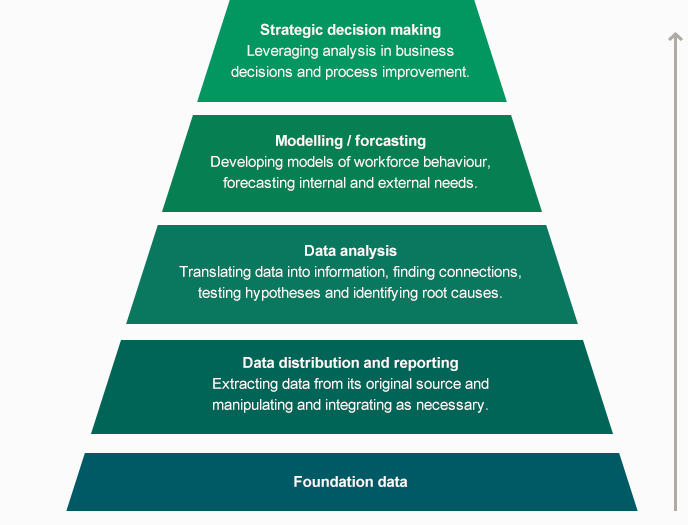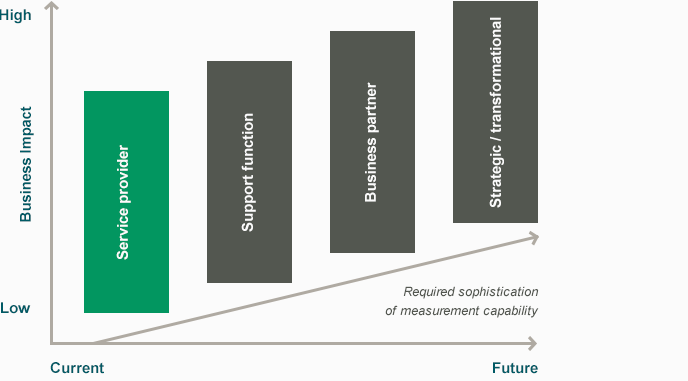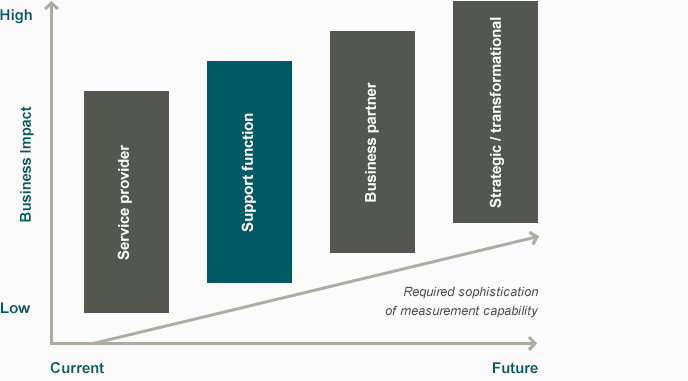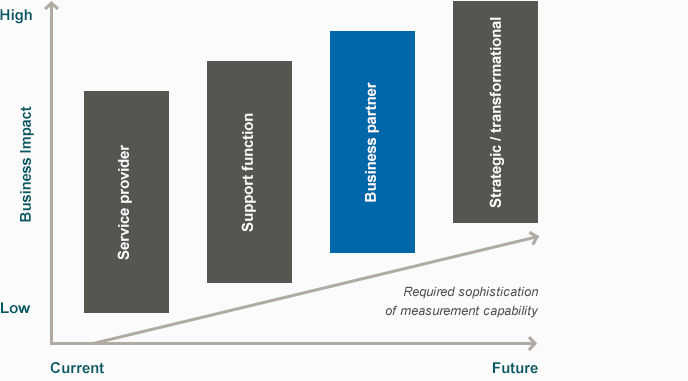Strategically used people metrics are powerful tools that assist the HR leader or manager to proactively influence strategy and predict the need for change. So how are people metrics used strategically?
Using people metrics strategically is about the manner in which the metric is used and applied. It requires the development of a sophisticated approach to selection, analysis and application.
Figure 1 represents the growing levels of sophistication in metrics application. As each layer moves up the pyramid, there is an increase in the level of sophistication or manner in which they are used, which allows them to be more influential over the strategic agenda.
Increasing sophistication means the HR professional can use people metrics to:
- define workforce drivers of success
- communicate the impact that future HR activities could have on the goals and objectives of the organisation
- provide a people perspective in organisational strategic planning.
Figure 1: Growing sophistication in people metrics
Source: Corporate Leadership Council
From Transactional People Metrics to Strategic and Transformational People Metrics
The approach to using people metrics will depend on the situation. It is not always appropriate to spend a lengthy period of time developing a sophisticated approach to issue measurement, and in turn a one- dimensional approach may not be thorough enough for the given situation or audience. How people metrics are integrated, analysed and communicated will need to change to suit the situation and the audience.
For the HR function to effectively support the organisation, and move its activities from the transactional to the transformational, it needs to develop a higher level of sophistication in metrics applicability. Developing a sophisticated approach to metric usage will result in more frequent data-driven decision making, and will better position HR to speak the language of the business and influence senior leadership.
On the following pages are four HR roles, some examples of how people metrics could be used within the role and the impact this has on the organisation.
These HR roles are as a:
- service provider to the organisation
- support function for the organisation
- business partner with the organisation
- strategic and transformational driver.
Human Resources as a Service Provider
One function of HR is to provide services to the organisation. This service provision is operational, supporting the day-to-day management of the workforce and may be generalist or specialist in nature.
Some of the services provided by the HR function include:
- provision of advice on policy and procedure
- delivery and coordination of learning and development interventions
- advising and coaching managers on the recruitment and selection processes
- coaching managers on the performance management process
- administration of systems that hold employment data
- management of the payroll function.
In the provision of these services, HR will collect data and maintain a database that captures workforce and HR history.
As a service provider, HR regularly use metrics in response to requests that include:
- information to support managers and executives
- requests for data and information from external agencies
- preparation of one-dimensional reports of past activities.
Some examples of the types of people metrics that would be used in this role include:
- a manager requesting a report on absenteeism days per employee
- the executive requesting a workforce classification breakdown
- a manager requesting the recruitment cost per hire.
At a point in time, the data collected and reports produced service a need or requirement in the day-to-day running of the workforce. The metrics used by the HR function in this role are generally confined to reporting on the current situation, and use information that measures past performance.
Human Resources as a Support Function
An important role of the HR function is to support the organisation with the tools that enable employees to access real-time services. Differing to the HR role as a service provider, this role supports the organisation’s employees to undertake activities themselves, from their own desktops. This support is provided in the administration of a number of online systems that managers and employees can access, to receive information about the workforce.
Some of the tools the HR function administers to support the organisation are:
- payroll systems
- systems that hold employment data
- online portals that allow employees to update personal information, access and apply for leave, and view pay information and personal employment information
- online performance management systems.
The administration of these online tools enables the HR function to:
- provide automated workforce reports
- set what the automated reports will produce, which consequently ensures consistency of measurement across the organisation
- support data self-service within and outside of the function.
Some examples of the metrics used in this role may include:
- the average annual leave or sick leave days of a particular organisational subgroup
- performance management information
- a calculation of training days per employee
- personal development plan prevalence.
The people metrics used in this role report on the current situation, so are only relevant at a given point in time. However, this is an important role performed by the HR function, and while these metrics can have relatively low impact on the organisation, they are still important in supporting business operations.
Human Resources as a Business Partner
The HR function advises the organisation about the impact of the workforce on overall organisational performance and identifies opportunities for improvement.
For example, workforce planning is one of the most critical HR management challenges currently facing the public sector, and requires organisations to plan and address issues proactively, rather than react belatedly to the business and environmental changes.
For example, HR has the responsibility to advise the organisation on the impact of skills shortages and the ageing workforce, and identify any opportunities to pre-empt loss of critical knowledge or skills.
Within the HR role as business partner, the practitioner will:
- identify problematic workforce trends
- define the opportunity for intervention by HR
- educate the organisation about the impact of workforce trends.
To undertake this role, the HR function will:
- undertake a workforce analysis establishing a clear understanding of the organisation’s direction
- forecast workforce needs
- analyse gaps between demand for services and the supply of labour
- develop strategies to address problematic workforce trends
- implement the specific programs
- and projects required to develop and maintain the capability and capacity of the workforce
- monitor and evaluate.
Some examples of how people metrics may be used in this role may include:
- a demographic analysis of people employed within the organisation to calculate age staffing breakdown, gender staffing breakdown and staffing rate 50+ years;
- a cross-analysis of people metrics including successor pool coverage, positions without a ready candidate, and leadership development plan rate to inform the organisation’s succession risk; and
- a cross-analysis of recruitment, employment brand strength and new hire failure rate, to establish if attraction strategies are being successfully implemented.
Human Resources as a Strategic and Transformational Driver
HR is a key function alongside finance and other core business areas that can help an organisation achieve its goals and objectives. For HR to be successful in this role, it needs to be aligned with the organisation’s strategy.
In this role the HR professional consults with the executive team so it can be more responsive, and proactively provide direction about how the workforce is best managed and leveraged, to drive organisational achievement of goals and objectives.
The HR professional uses people metrics in order to:
- define workforce drivers of success
- communicate the impact that future HR activities could have on the goals and objectives of the organisation
- proactively identify people issues and influence strategic conversations
- provide a people perspective in organisational strategic planning.
To use people metrics in a strategic and transformational way requires the greatest level of sophistication in planning and selection, to ensure alignment with objectives and clear, accurate insight into the issue. Significant business impact can be achieved if HR can perform this role successfully.
How people metrics are used in this role will depend on the organisational strategic frameworks, structures, expectations of the HR function, and existing capabilities within the organisation to undertake a sophisticated analysis of issues.
Some examples of how people metrics may be used in this role include:
- identifying the people elements critical to the organisation meeting its goals and building a model of people metrics that inform activities toward those goals or objectives
- as business intelligence gathering, based on an identified or hypothesised business needs.
On the following pages are some principles to guide strategic and transformational use of people metrics. These principles also pose questions to consider in a strategic and transformational approach.





